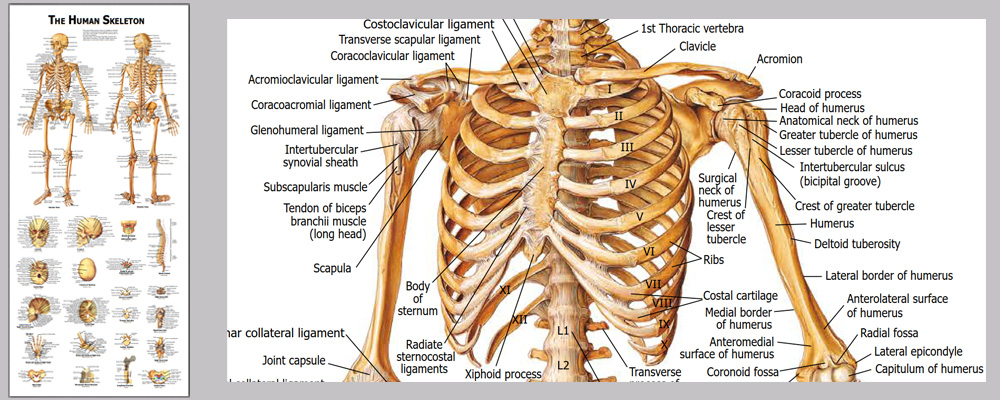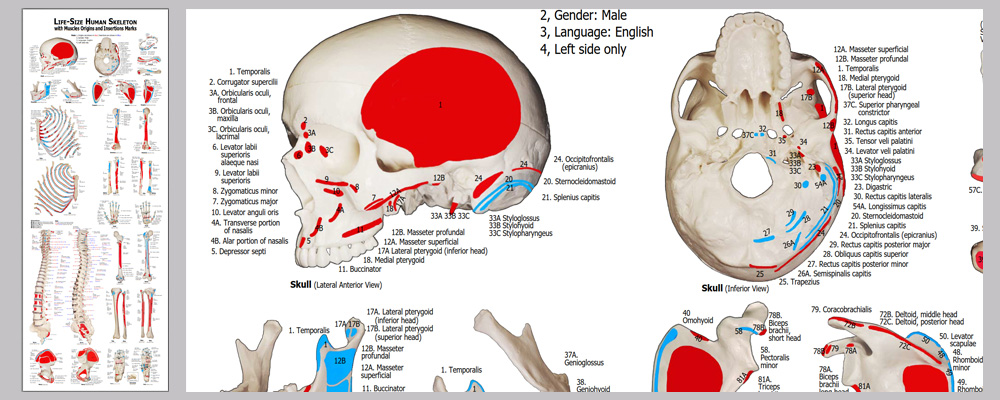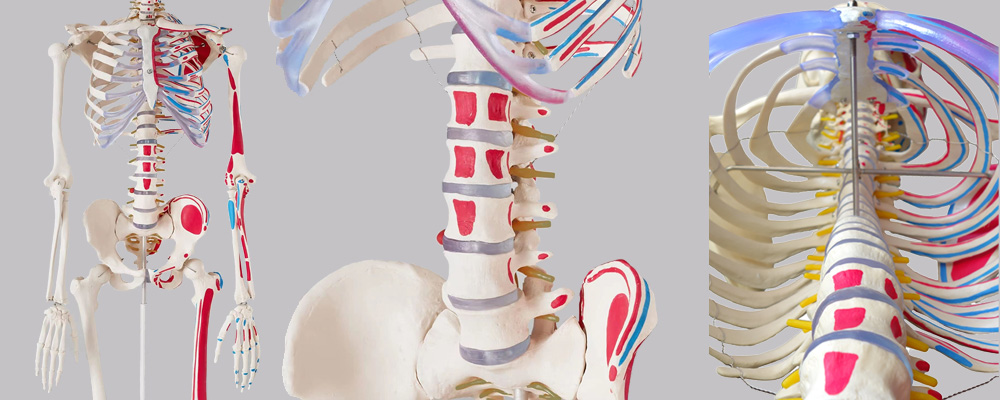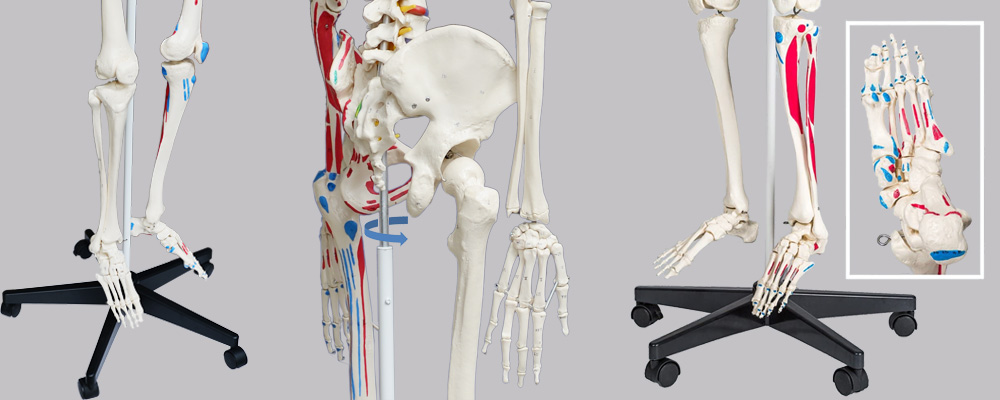human skeleton with organs model
This life size articulated adult human skeleton model is 180cm tall & ideal for teaching / learning the basics of human anatomy. Includes a colorful Human Skeleton chart to show all the detailed structures for reference.Detailed colorful chart with over 630 accurate definitions. Durable and no reflection with matte film covered, 36 * 78cm

Detailed muscles origins and insertions with codes. Durable and no reflection with matte film covered, 100cm * 38cm

Stainless steel wires keep the ribs gaps stable.

2 of 5 casters are lockable.

An overview of JC anatomy advantages: • Hand-painted muscle origins and insertions • Flexible spine and ligaments • Slipped disc between the 3rd and 4th lumbar vertebrae • Protruding spinal nerves and vertebral arteries • 3-part assembled skull with individually inserted teeth • Made from a durable, unbreakable synthetic material • Top quality, life size natural casting • lMultiple Applications -chiropractor,decorate,photography, etc. • lChart - Detailed colorful chart with about 780 accurate definitions. Durable and no reflection with matte film covered, 36 * 78cm • On a stable metal stand with 5 casters (painted white) • Full size dust cover keeps model clean while in storage • Exceptional value for money with a 3 year guarantee • human skeleton with organs model Easy to use - Main joints are movable. Skull, skullcap arms, legs, crus, feet are removable.
| Product name | human skeleton with organs model |
| Place of Origin | Shenzhen China |
| Product Material | PVC, ABS, SST |
| Rib cage | A 5mm dia |
| Human skeleton model life | 20years |
| Surface treatment | Polish. Etched. Texture |
| SUPPORT 24/7 | Contact us 24 hours a day, 7 days a week |
| Size | 88 * 59 * 92 |
| Port | Shenzhen |
| PAYMENT & ORDERING | PayPal account or pay by credit card |
human skeleton with organs model FAQs Guide Are you looking for a quick review guide about human skeleton with organs model? An ultimate FAQs buying guide is available to help you.This guide contains all the information about all the important facts, figures, and various processes regarding human skeleton with organs model. Let’s continue!
2.Can the human skeleton with organs model be disassembled and assembled to facilitate learning and display?
3.Can bone diseases such as osteoporosis be displayed on the human skeleton with organs model?
4.human skeleton with organs model Can it be used as a teaching aid?
5.About human skeleton with organs model payment method
6.How much weight can human skeleton with organs model hold?
7.Does the human skeleton with organs model have movable joints that can show the range of motion of various parts of the human body?
8.Does this human skeleton with organs model include all human skeletal systems?
9.What are the different types of human skeleton with organs model available?
10.Why is a human skeleton with organs model important in medical education?
11.Is this human skeleton with organs model suitable for anatomy learning?
12.About human skeleton with organs model delivery date
1.About human skeleton with organs model warranty
3 years. If any problem occurs with the model due to material or structural defects, it will be repaired or replaced free of charge to the buyer
2.Can the human skeleton with organs model be disassembled and assembled to facilitate learning and display?
Yes, many human skeleton models are designed to be disassembled and assembled for educational purposes. The bones are typically connected by metal or plastic clips that can be easily removed and reattached, allowing for the skeleton to be taken apart and put back together. This feature makes the model useful for learning about the different bones and their connections, as well as their placement in the body. Students can learn the names and locations of each bone by taking them apart and reassembling them in the correct order. This hands-on approach can be helpful for visual learners and can make the learning process more engaging and interactive.
3.Can bone diseases such as osteoporosis be displayed on the human skeleton with organs model?
Yes, bone diseases like osteoporosis can be displayed on a human skeleton model. A human skeleton model is a representation of the bones and joints of the human body and can be used to educate and train students and medical professionals. Osteoporosis is a bone disease that results in weakened and porous bones, increasing the risk of fractures. As a result, there are certain features and changes in the bone structure that can be seen on a human skeleton model.
4.human skeleton with organs model Can it be used as a teaching aid?
Yes, a human skeleton model is a commonly used teaching aid in various academic fields such as anatomy, biology, and medical education. It is an accurate and detailed representation of the human skeleton, providing a visual aid for students to understand and grasp the complexities of the skeletal system.
5.About human skeleton with organs model payment method
TT, or Paypal
6.How much weight can human skeleton with organs model hold?
The amount of weight a human skeleton model can hold depends on the materials used to make it and the structural integrity of the model. Generally, a human skeleton model made from plastic or resin can hold up to 5-10 pounds of weight. However, this weight limit may vary depending on the size and design of the model. If the model is designed to be articulated and movable, it may have a lower weight limit as the joints and connections may not be able to support heavy weights. On the other hand, a solid and non-articulated skeleton model made from sturdy materials such as metal or wood may have a higher weight limit of around 20-30 pounds.
7.Does the human skeleton with organs model have movable joints that can show the range of motion of various parts of the human body?
Yes, the human skeleton model typically has movable joints that can show the range of motion of various parts of the human body. These joints are usually represented by different types of articulations such as ball and socket, hinge, saddle, pivot, and gliding joints, which mimic the movement of the actual joints in the human body. For example, the shoulder joint of a human skeleton model will have a ball and socket structure that allows for a wide range of motion, similar to the shoulder joint in a real human body. This joint is able to rotate 360 degrees and can also move forward, backward, and sideways. Similarly, the elbow joint in a human skeleton model will have a hinge structure that allows for flexion and extension movements, just like the elbow joint in a real human body. This enables the model to accurately demonstrate movements such as bending and straightening of the arm.
8.Does this human skeleton with organs model include all human skeletal systems?
It depends on the model in question. Some Human skeleton models may include all human skeletal systems such as the axial skeleton (skull, vertebral column, ribcage), appendicular skeleton (arms, legs, shoulder girdle, pelvic girdle), and cartilaginous skeleton (cartilaginous structures such as the nose and ears). However, others may only include certain systems or be limited to specific areas of the body. It is important to carefully read the product description or ask the manufacturer for a detailed list of what is included in the model to ensure that it meets your needs.
9.What are the different types of human skeleton with organs model available?
1. Anatomical Skeleton Models: These models are exact replicas of the human skeletal system and are used for educational and medical purposes. They are typically made of high-quality materials such as plastic or resin and come with detailed labels for each bone, making it easy to identify and study different structures. 2. Disarticulated Skeleton Models: These models consist of individual bones that can be separated from each other. They are often used in classrooms for teaching purposes as they allow students to handle and study each bone individually, facilitating a more hands-on learning experience. 3. Flexible Skeleton Models: These models are made from a flexible material such as rubber or PVC and are designed to mimic the movements of the human body. They are often used in medical training and rehabilitation settings to demonstrate muscle and joint movements. 4. Life-size Skeleton Models: As the name suggests, these models are the same size as an actual human skeleton. They are most commonly used in medical schools and hospitals for teaching and training purposes.
10.Why is a human skeleton with organs model important in medical education?
Better understanding of the structure, function, and pathological changes of the skeletal system. Deeper understanding of the pathogenesis of skeletal diseases. To demonstrate and explain treatment methods for skeletal diseases
11.Is this human skeleton with organs model suitable for anatomy learning?
Yes, this human skeleton model is suitable for anatomy learning for several reasons. 1. Lifelike appearance: The model closely resembles the human skeleton in terms of size, shape, and detail. This makes it easier for students to visualize and understand the placement and functioning of bones in the human body. 2. Detailed labeling: The model comes with detailed labeling of all the bones and structures, helping students to learn the correct terminology and understand the location and function of each bone. 3. Removable parts: The model has removable limbs, joints, and other parts, allowing students to explore and study the underlying supportive, connective, and reproductive structures, such as ligaments, tendons, and cartilage. 4. Durable materials: The model is made of high-quality, durable materials that can withstand regular handling, making it suitable for use in classrooms, laboratories, and homes. 5. Realistic movement: The model's limbs can be moved in a way similar to human movement, making it an effective tool for demonstrating physiological processes and the range of motion of different joints. 6. Interactive learning: This model can be used in interactive learning sessions, such as small group discussions and hands-on activities, to foster a deeper understanding of the human skeleton and its functioning.
12.About human skeleton with organs model delivery date
Around 40 days. Depends on qty.




